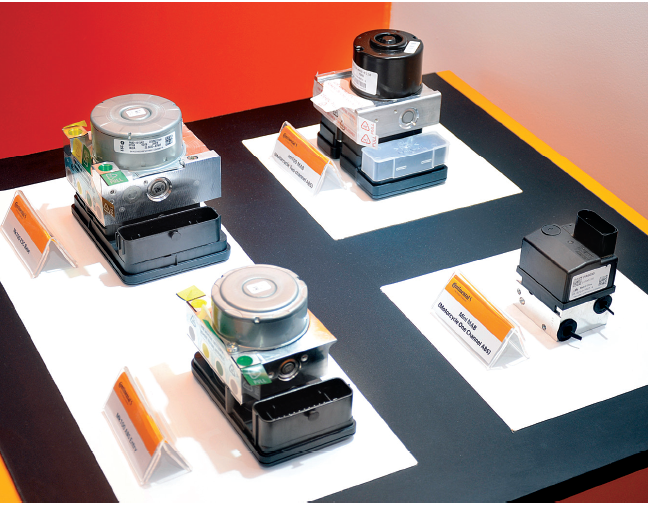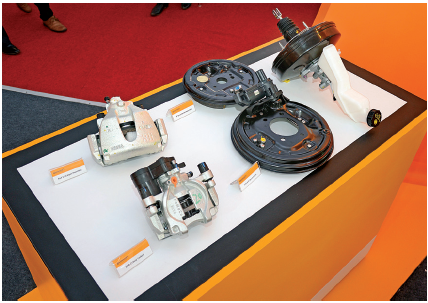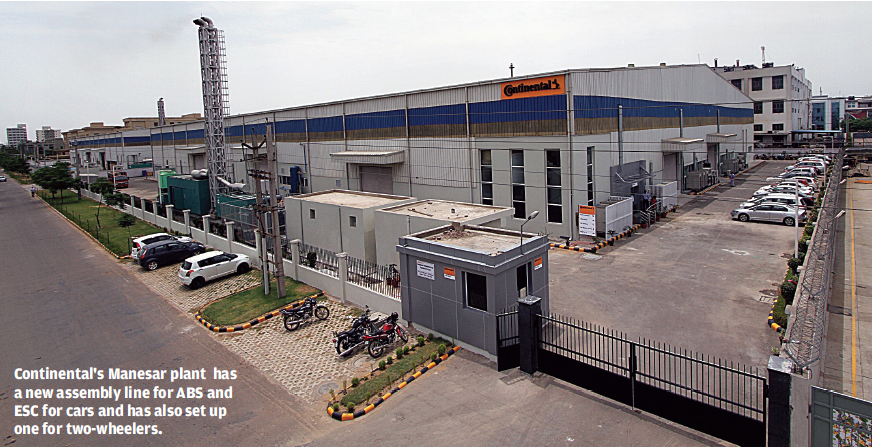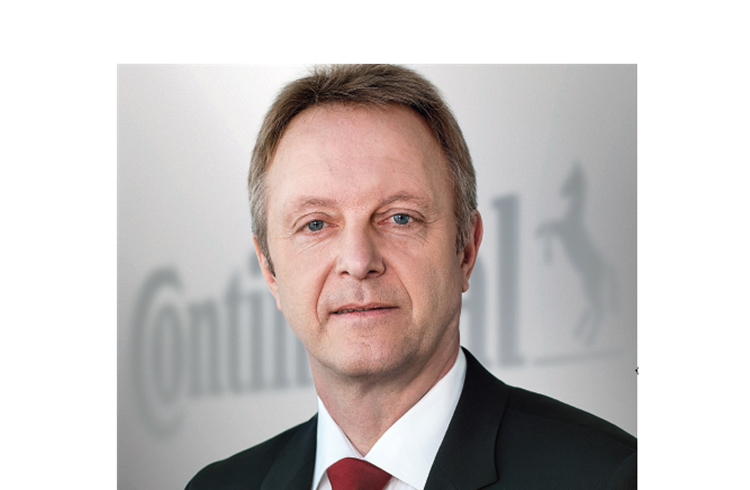'Combining the ADAS camera, radar and the driving dynamic systems with algorithms opens up significant additional possibilities to bring more safety to the real world.'
Continental makes ABS and ESC systems at its Gurgaon plant. They include MK100 ABS, MK100 ESCand singleand two-channel ABS for two-wheelers.
Continental’s executive vice-president (Business Unit Passive Safety and Sensorics) and member of the Management Board speaks on manufacturing airbags and electronic brake systems locally, why India needs to have the latest life-saving technologies, and how the country’s sharper focus on safety spells a growing business opportunity for the company. Dr Bernhard Klumpp met Kiran Bajad in Bangalore recently.
Continental’s Chassis & Safety division has been consistently driving technological advances. What is the key goal?
We as the chassis and safety division and as a business unit are dedicated to Vision Zero with zero fatalities, zero injuries and zero accidents. This is the direction we are working on and the entire division is dedicated to this vision. However, we have specific focus as regards enhancement of passive safety. In the event of a crash, we provide not only the crash sensor and electronic system but also the software functionalities to protect the occupants in the car. We have delivered to customers, in series, an expansion of such passive safety but in a more integrated approach.
Today, we are talking about integrated safety which is the move from the passive to the active safety area. We are enhancing protection for vehicle occupants. Our motto is connecting sensors and protecting people. We take all the information available and make sure that finally in a crash situation, people are protected.
How realistic is Vision Zero and by when is it possible to achieve this vision?
This is our clear, futuristic vision. It is not possible to set up a specific time-frame to achieve Vision Zero but we are working in that direction. The incidence of accidents and fatalities is showing that with the introduction of active and passive safety systems as well as with stronger connectivity, we are able to reduce fatalities. In Germany and the US, we have been able to reduce the fatality rate in the past 15 years significantly. This has been achieved by the introduction of seatbelts, airbags, anti-lock braking system (ABS) and Electronic Stability Control (ESC).
The next steps coming up in India include driver assistance systems and sensors for these systems. It’s also about the real situation during a crash. Passive safety systems are set up in the laboratory conducting crash tests but the real world is partially different. Being able to use the ADAS camera, radar system and driving dynamic systems, and combining them with algorithms opens up significant additional possibilities to bring more safety to a real-world scenario.

Going forward, what are the challenging areas you foresee from a safety perspective, things which will take you closer to Vision Zero?
Emergency Brake Assist is in serial production and then there is Emergency Steer Assist support, which is also in an introduction stage.
The next step will come with the connection of systems so that there is no additional technology, except V2V and V2X communication. We are providing the V2X system for the market and developing solutions. This is next-gen technology but besides this, it’s all about function and information integration and letting different systems communicate with each other much better.
Compared to developed markets, India is very different in terms of road infrastructure, driving patterns, safety and awareness. Do you see India providing greater business opportunities for Continental?
We don’t develop specific solutions for any market including India because we believe safety is a must for everybody, independent of how much money it costs. What will drive safety adoption in India will be (mandatory) ABS and may also be for ESC in the near future. Continental is ready with its solutions and as and when the market demands, we will deliver.
How do you view the safety scenario in India?
We clearly see India as an automotive market which is moving towards greater safety. We saw this and invested in India 6-7 years ago in safety technologies for both production and development. We see safety as a must for everybody and I observe now the market itself is pulling for safety. A number of our customers are promoting safety in their cars in India significantly. This is a clear indication that the market is pulling from the consumer's side. We foresee clear awareness on safety in the market. It is something that is urgently needed, given the number of fatalities taking place in India.
In India commercial vehicles are among the major causes of accidents. Do you focus only on passenger cars and two-wheeler safety solutions?
Emergency Brake Assist is also important for trucks and buses. As an organisation, we also deal with commercial vehicles, especially emergency brakes. We also support other suppliers which are more focused on trucks and clearly see a huge advantage for commercial vehicles.
Globally automotive safety has been driven largely by legislation, customer awareness or initiatives by industry stakeholders. What is your point of view?
This all depends on market to market. In some cases, a market develops a sharper approach towards safety by itself while in others legislation has made the breakthrough. In Europe, it was a balance between regulation and customers moving towards safety. In some cases, customers didn’t want to have regulation but have done it themselves.
Markets like India and Brazil have seen regulation play a major role. The US is pushing regulations for B2B communication and airbags because it clearly sees that the relation between accident avoidance and reduction of accidents and fatalities lies in better communication between cars. The North American market is going in for legislation for the next level of safety enhancement.
How do you see safety playing out with the emerging technologies like autonomous cars and electric vehicles?
Emerging technologies definitely need higher safety measures and we are developing safety concepts for such cars. We still have a scenario where not all the cars are driving autonomous in the next 5-10 years and still have a lot of mixed traffic. But as a technology player, we are working on technologies which are going towards this direction with regard to such technologies.
What is the major focus area for Continental in developing markets like India?
We are supporting the Indian market in airbags and electronic brake system production. We have nearly full development capabilities and are expanding further. Electronic braking systems facilitate a huge step possible in traffic safety and there is an additional functionality of step-by-step introduction in the short to medium term. The Indian market is taking a massive leap in the next 2-3 years implementing new safety technologies; ensuring that the market accepts them well is a big step forward.

New safety norms are set to come into force in India in the next few years. Which areas offer new opportunities for Continental in India?
Safety in India is now clearly a priority. Earlier, only top-end models of cars would have ABS and airbags but today this has changed. Even the Top 10 selling cars and entry level cars have all the key safety features. This is clearly an opportunity for us. The Indian automotive market is growing rapidly and the growing demand for safety products offers a lot of opportunities in India. We have an advantage clearly because we made our beginning 4-5 years ago with our technologies and presence in the market.
How is Continental leveraging Indian technical talent for India and its global products?
We have competencies in India which are supporting our products in India. Our current focus has been brakes and airbags. We have a development centre in India and already have the competencies for the world. India plays a big role for us in R&D globally with a significant contribution coming out of Bangalore. We are heavily counting on India with a competent organisation with exceptional people. The spirit of the Indian team also counts for the future.
What is the status of localisation for Continental in India?
The airbag system is just the starting point and we decided to bring it to India as technology, production and R&D competencies. We did the same for electronic brake systems; we also have a normal brakes system plant in India. So with electronic brakes and airbags, production of which has just started, we definitely foresee significant growth for such components.
As regards sourcing locally, India is good in mechanical parts but the electronics are still imported. Our products are highly electronic, so we need to source them from relevant markets. However, this is an ongoing process and we definitely want to increase local content. 
(This interview was first published in Autocar Professional's 1st August 2017 Issue)
RELATED ARTICLES
Setrans Mobility Booster Charging top-up 25% EV range in 15 minutes
Two enterprising tech-savvy entrepreneurs Rana Roshan Singh and Vivek Ummat of Noida, Uttar Pradesh-based start-up Setra...
'Our products are proudly 100% designed and made in India'
Creatara Mobility, a New Delhi based electric two-wheeler startup, claims to have tackled various challenges in making i...
'EVs have been around for a much smaller time than ICE, so best practices are still evolving'
EV OEMs and start-ups are under pressure to reduce production costs and bring them close to ICE counterparts. Vaibhav Ku...





 23 Aug 2017
23 Aug 2017
 6095 Views
6095 Views





 Autocar Pro News Desk
Autocar Pro News Desk




